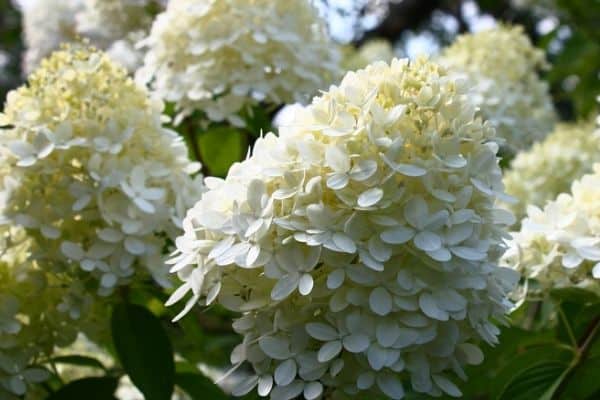Limelight hydrangeas (Hydrangea paniculata ‘Limelight’) are hardy perennial shrubs that can tolerate a wide range of conditions.
They’re easy to care for and ideal for beginner gardeners.
Here’s how to grow beautiful limelight hydrangeas in your garden.
This post contains affiliate links. Please read the disclosure for more info.

Hydrangea paniculata ‘Limelight’ is native to Japan and China but they’re found in many different countries including the USA, Australia and Europe.
Limelights are deciduous, which means they lose their leaves in the winter and they flower on new wood from mid summer to fall.
You can plant one limelight hydrangea as a focal point in the garden or use them to create a beautiful flowering hedge.
As an alternative you can also plant little lime hydrangeas, which only grow to about half the size of limelight hydrangeas.
Flowers
The flower clusters, known as panicles, are densely packed and cone shaped, similar to the flowers of the lilac tree but a bit bigger.
The conical flower heads can be 6 to 12 inches (15 to 30 cm) in length and they’re distributed evenly on the plants, making a stunning display.
The flowers start out a soft lime green color in mid summer before turning white, light pink, dark pink or burgundy in fall.
Some varieties of hydrangeas will change color depending on the acidity of the soil but limelights don’t change color because of the soil.
The flowers look stunning as cut flowers in a vase and they can also be dried for long lasting flower arrangements.
It’s best to leave the flowers on the shrub until fall when they’ve developed their final color.

Climate
Limelight hydrangeas are suited to a wide range of climates and will grow well in USDA plant hardiness zones 3 to 9.
In cool climates they can be planted in a spot that receives all day sun and in warmer climates they’ll grow best somewhere that receives morning sun and afternoon shade.
Soil
Hydrangea paniculata ‘Limelight’ will grow well in most soil types including slightly alkaline or acidic soils.
Limelights are susceptible to root rot and fungal diseases so the soil needs to be easily draining.
Avoid planting them in low lying areas where the soil can become waterlogged.
It’s a good idea to dig in some compost or broken down manure before planting, especially if you have heavy clay soil.
Planting
To plant a limelight hydrangea shrub, dig a hole that is about two feet wide and as deep as the plant’s roots.
Remove the plant from the pot and place it into the hole at the same depth as it was in the pot.
Fill in the rest of the hole with soil and give the plant a deep watering.
Add a layer of mulch around the base of the plant to protect the roots and keep the soil moist.

Spacing
Hydrangea limelights can grow 6 to 8 feet (1.8 to 2.4 metres) wide so they need plenty of room to spread out in the garden.
If you’re planting a hedge of limelights it’s best to space them out at least 5 to 6 feet (1.5 to 1.8 metres) wide, depending how dense you want the hedge to be.
Keep the area around the plants clear so that they’re not competing with ground covers or other plants.
Sunlight
Limelight hydrangeas will grow well in full sun or partial shade but they’ll need afternoon shade in hot climates.
Too much direct sun in very hot weather will cause the flowers to turn brown and the foliage will become wilted.
On the other hand if the plants are shaded too much they’ll produce less flowers.
Water
Hydrangea limelights are drought tolerant once they’re established but they need regular watering while the plants are young.
Give the plants a deep watering at least once a week and allow the soil to dry out slightly in between waterings.
Pruning
The best time of year to prune limelights is in late winter or early spring before the buds appear.
Cut the stems back by one third and remove any diseased or damaged stems.
I also like to remove the suckers from the base of the plants to keep them looking tidy.
The flowers are held upright by strong stems but they may start to droop if they’re not cut back each year.
Fertilizer
Hydrangea limelights can be fertilized in spring and late summer to promote beautiful big blooms.

Pests and diseases
Hydrangea limelights are fairly low maintenance but they can be affected by powdery mildew, which is a type of fungus that looks like white or gray powder on the leaves.
Check the plants regularly and if you see any leaves that are affected by powdery mildew you’ll need to remove them and spray the plant with a fungicide.
The new growth can also be affected by aphids but they can be eliminated with a natural insecticidal spray.
Root rot is another common problem with limelights but if you choose a spot with well draining soil and take care not to overwater the plants you shouldn’t be troubled by root rot.
Propagation
Limelights can be propagated by taking cuttings in early fall.
Choose stems that have new light green growth and no flowers.
Take a few cuttings that are about 6 inches (15 cm) in length and cut just below a leaf.
Remove the leaves from the bottom half of the cuttings and dip the cuttings into rooting hormone powder or gel.
Place the cuttings in a pot with vermiculite, perlite or sand.
Cover the pot with a plastic bag and place it in a well lit spot away from direct sunlight.
After a few months you can move the cuttings to a bigger pot or plant them out in the garden.
Are limelight hydrangeas frost tolerant?
Freezing winter conditions will cause the plants to die back but they’ll come back with new stems in the springtime.
It’s a good idea to add a thick layer of mulch around the plants to help retain moisture in the soil and protect the roots during winter.
How tall do limelights grow?
Limelights can grow up to 8 feet (2.4 metres) or more in four to five years if they’re not pruned regularly.
Regular pruning will keep the shrubs to a manageable size of about 6 feet (1.8 metres).

Can limelight hydrangeas be grown in containers?
Yes, they can be planted in large containers with well draining potting mix.
You can prune limelights into a small tree shape and they look beautiful in containers.
Toxicity
Limelight hydrangeas can cause mild stomach upset if they’re ingested. [1]
The foliage can also aggravate skin allergies, so it’s a good idea to wear gloves if you have sensitive skin.
How long do limelight hydrangeas take to mature?
It can take about 4 to 5 years for limelight hydrangeas to reach their full size, depending on the conditions.
Summary
- Full sun for cool climates
- Partial sun for warm climates
- Can grow 6 to 8 feet tall
- Hardy in USDA zones 3 – 9
- Blooms from mid summer to fall
- Prune in late winter or early spring before the buds appear
So there are my limelight hydrangea plant care tips.
With the right care you’ll be able to enjoy the attractive foliage and spectacular flowers of these shrubs for many years to come.
RELATED ARTICLES
- Best Small Hydrangea Varieties
- 15 Red Flowering Shrubs
- 15 Drought Tolerant Flowers
- 10 Yellow Flowering Shrubs
Have you tried growing limelight hydrangeas in your garden? Let me know in the comments below.
Are you on Pinterest? I have boards dedicated to Flowering Plants and Gardening Tips that you may enjoy. You can also find me on Facebook.






I planted (5) Limelight hydrangeas last fall to create a large 20ft flowering hedge and I’m hoping for large 8 foot plants. I gave them a prune in the early spring and they seem to be growing well with flowers starting to form (as of July 12th) but they are barely 3ft tall. Is this normal for the first year for them to remain short? Will it take the 4-5 years to maturity to get the height I’m a hoping for?
Hi Suzy, yes it’ll take a number of years for them to reach their full height.
Thanks so much, was sad to see them so short yet healthy and full. Now I know….it is just a waiting game.